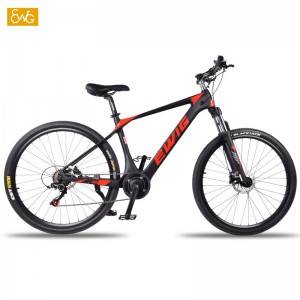For most riders, carbon is synonymous with the best: desirable, remarkably light and, of course, extremely high-performance. However, there is hardly any material surrounded by more myth! Regardless of whether it’s a frame, wheel, or handlebar, most of us would almost always choose the carbon version given the choice between carbon or aluminium. The fact that carbon is supposedly better than aluminium is suggested to us in the form of lofty prices and slick marketing. Recommendations for lightweight components, performance upgrades, and the message sent by most brands flagship models tell us carbon is best. Carbon fiber bike from China manufacture and aluminum each have advantages and disadvantages when it comes to bike frame material. Considering comfort, weight, stiffness, durability, cost, and looks, which is better? Which is right for you?
Are aluminum bikes harsh?
The conventional wisdom in cycling has been that aluminum is stiff and harsh, while carbon is compliant and smooth. It was true 20 years ago, when aluminum frames were unrefined. Aluminum is actually a fairly soft metal, so in the early days, builders used thick, oversized tubing for strength and durability. This made aluminum frames super-stiff — fine for racers, but too harsh for everyday riders. Ride quality has long been a claimed benefit of carbon frames. Carbon can be engineered to be stiff in certain directions and compliant in other directions. This means a China carbon frame can be comfortable over bumps and rough roads yet simultaneously efficient under pedaling.
Why is a carbon bike more responsive?
Modern bikes are amazingly stiff and responsive without feeling punishingly harsh. When you push hard on the pedals or dive into a corner, a good frame needs stiffness to resist the torsional forces that rob you of power or derail your bike's handling.Does one material do this better than another? Technically, carbon comes out on top. With aluminum frame bikes , mountain bike manufacturers use different tube shapes and varying thicknesses to control the ride characteristics. But fundamentally, Carbon fiber simply has more potential for engineers to tune ride quality. By simply changing the carbon layup (the direction that carbon fibers are oriented), it can be made stiff in one specific direction, and in one specific area.
Stiffness of a Carbon Mountain Bike vs. Aluminum
Tiffness is how much your bike resists bending. The stiffer the bike, the less effort you need to control it. With a carbon mountain bike, you are looking at two kinds of stiffness: the lateral stiffness and the stiffness of its handling. The former affects the transition of your energy from pedal to the road, while the latter determines your bike’s predictability when being controlled.
Carbon is stiffer than aluminum. It responds more quickly to forces on the pedals and handlebars. This quality makes it easy to control but might offer some disadvantage when running through high-speed runs and encountering substantial obstacles. Here is a carbon MTB with a high stiffness. Manufacturers are making aluminum frame tubes a larger diameter to increase stiffness. Moreover, advances in welding and hydroforming are creating stiffer and lighter aluminum models.
Overall, the choice between carbon and aluminum depends on you. In terms of stiffness, carbon still reigns supreme, but aluminum is slowly offering a competitive edge. While cost may not be the central part of your decision, if you go with a cheaper aluminum frame mountain bike, it will not disappoint.
Are aluminum bikes more durable?
Many riders are afraid of damaging an expensive carbon frame. Carbon fiber's strength to weight ratio is higher than steel and carbon frames can survive a lot of abuse. It also has a nearly infinite fatigue life and, under perfect conditions, long-term use won't "wear it out." The resin, however, can degrade when exposed to UV light, but that’s why frames are painted, even "raw" frames have clear coats with UV inhibitors built in.The biggest risk is that carbon is still susceptible to cracks and other damage from direct impact, as you'd experience in a big crash. Fortunately, carbon can be easily repaired, and when done correctly, the repaired frame's performance and durability is indistinguishable from when it was new. That's something that can't be said for aluminum.
In the word,aluminum has long been used to make lightweight and durable mountain bike frames. This material was once considered the pinnacle of mass production mountain bikes once it replaced the heavier stainless steel. It happened because bikers worldwide were looking for lighter frame materials to handle the bike more efficiently without losing the sturdiness.There are multiple options available for you out there to go for. But in this comparison of Carbon Fiber vs Aluminum, carbon fiber reigns superior. It is more expensive than Aluminum, but it is far sturdier and lighter too.You will end up lightening your wallet a bit more, but the performance boost you will get along with the weight savings should be your ultimate goal if you are looking to get the most out of your ride.
It’s not just about going for lighter materials. You also need to consider their strength, durability, and overall ride experience. If you can afford a carbon fiber mountain bike, then go for it. If you can’t, then Aluminum is not a bad option, but it is significantly better than titanium or steel.

Post time: Jun-08-2022
